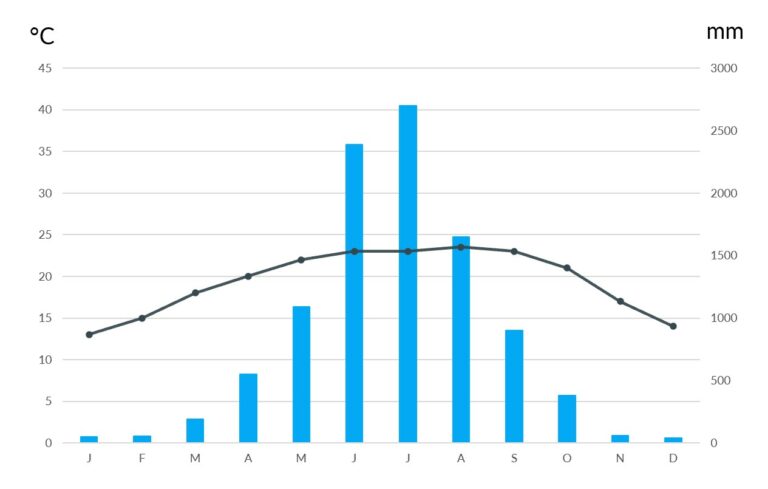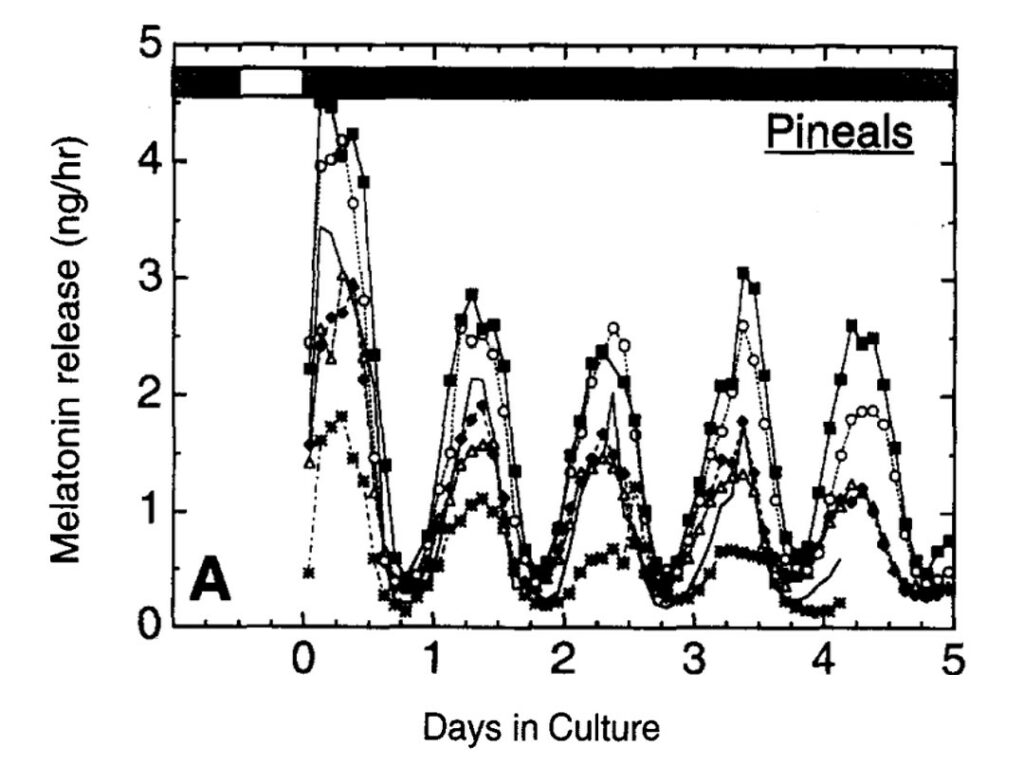Summer is here and we can enjoy the long days. Longer days allow us to be more active and can give us more energy. But what about animals? Do they perceive the changing of the seasons? This month we are going to discover how zebrafish perceive environmental changes such as light and temperature.
Natural range
Zebrafish are found in the river Ganges and its branches in India, Bangladesh and Nepal. They can also be found in Sri Lanka and Myanmar. These regions are characterised by a monsoon climate with a dry, hot season and a season with heavy rainfall and lower temperature (1,2). The largest amount of water falls between the months of April and September. During this time, rainfalls are heavy and can create floods (3). For the month of July, rainfall can reach 2700 mm (4). In 1861, Cherrapunji, an Indian city, accumulated up to 9299 mm in only a month and set a new record for rainfall in a single month.
Concerning the daylight duration, variations are observed during the year. In fact, in January, the day lasts 10,5 hours while in June the day length is 14 hours (5).


Monsoon impacts on zebrafish
For species living in a seasonal environment such as monsoon climate, they have to perceive changes in rainfall. This is important because the amount of rainfall induced floods, which can represent problems for terrestrial animals. Grazing animals may have difficulty to find food and animals’ homes may be destroyed (6).
For aquatic animals such as zebrafish, the monsoon is synonymous with changes in microhabitats. Indeed, an increase of water flow influences the locomotion, the behaviour and the communication between individuals (7). An increased water flow leads to a perturbation in the hierarchy of the group. In fact, in weak flow, zebrafish are more aggressive and maintain less cohesive shoals (7). During the monsoon, days are longer and zebrafish present higher fertility and increased growth (9). Locomotion is also affected because zebrafish are territorial animals and are determined to maintain their position in the river or pound. When water flow increases, zebrafish use up a lot of energy to maintain their position by swimming against the flow (7).
Furthermore, heavy rainfall also contributes to soil leaching. As a result, fertilisers and pesticides used on crops can find their way into water sources much more easily. In that way, toxic compounds can be found in ponds and may cause dysfunction in the ecosystem.
Perception of seasonality
Zebrafish are able to perceive seasonality through photoperiod. The photoperiod represents the ratio between the length of day and the length of night. Photoperiod regulate reproduction, development, sexual maturity and also migration in some cases (8). For zebrafish, the main period of growth appears during the monsoon season and the spawning begins just before the onset of the monsoon (2).
Photoperiod is essential to be perceived because it synchronises circadian rhythms such as growth, reproductive states and locomotion (9). But what is the circadian rhythm ? It refers to the circadian clock, an internal system that allows organisms to synchronise their metabolism with environmental cues and more particularly with light/night. Circadian clock regulates processes in 24-hour cycles.
In zebrafish, the amount of pineal melatonin in blood circulation oscillates through the season (10). Melatonin is a hormone produced by the pineal gland. The hormone in circulation acts as a signal to coordinate rhythms through the animal. The coordination is made by gene activation or inhibition (9, 10). Activation or inhibition of clock genes are the result of a long pathway with positive and negative feedback loops.
Zebrafish with mutation in the circadian clock pathways present lower melatonin production and impact the locomotion (11).

For zebrafish in tanks, breeding can occur during the entire year because tanks are highly regulated and there is no light variation (2).
Zebrafish are more and more used to study circadian clocks (9,11). In the laboratory, it is important that the embryos used in research do not have any malformations that could alter the results. So sorting eggs with the EggSorter not only saves time, but also automatically ensures that the eggs are in good health.
Conclusion
In the wild, zebrafish metabolism is highly sensitive to the duration of light. The arrival of the monsoon corresponds to longer days. Metabolism in zebrafish is influenced by photoperiod which is perceived by the circadian clock.
So when the monsoon arrives, zebrafish present higher fecundity, growth and locomotion. When we have more energy in summer, it is in a certain way the same for zebrafish, which are more active so they can swim in bigger flows and breed.
References
- Parichy DM. Advancing biology through a deeper understanding of zebrafish ecology and evolution. eLife. 4:e05635.
- Spence R, Fatema MK, Ellis S, Ahmed ZF, Smith C. Diet, growth and recruitment of wild zebrafish in Bangladesh. J Fish Biol. 2007;71(1):304–9.
- Monsoon [Internet]. [cited 2023 Jun 22]. Available from: https://education.nationalgeographic.org/resource/monsoon
- MétéoSuisse-Blog – MétéoSuisse [Internet]. [cited 2023 Jun 22]. Available from: https://www.meteosuisse.admin.ch/portrait/meteosuisse-blog.html
- C’est la durée de l’ensoleillement en Inde ! Jusqu’à 14 heures de lumière du jour par jour. [Internet]. DonnéesMondiales.com. [cited 2023 Jun 22]. Available from: https://www.donneesmondiales.com/asie/inde/coucher-soleil.php
- Kolay S, Annagiri S. Dual response to nest flooding during monsoon in an Indian ant. Sci Rep. 2015 Sep 8;5(1):13716.
- Suriyampola PS, Sykes DJ, Khemka A, Shelton DS, Bhat A, Martins EP. Water flow impacts group behavior in zebrafish ( Danio rerio ). Behav Ecol. 2017;28(1):94–100.
- Condon CH, Chenoweth SF, Wilson RS. Zebrafish take their cue from temperature but not photoperiod for the seasonal plasticity of thermal performance. J Exp Biol. 2010 Nov 1;213(21):3705–9.
- Olsen J. Seasonality in Zebrafish. Univ Coll Lond.
- Cahill GM. Clock mechanisms in zebrafish. Cell Tissue Res. 2002 Jul;309(1):27–34.
- Vatine G, Vallone D, Gothilf Y, Foulkes NS. It’s time to swim! Zebrafish and the circadian clock. FEBS Lett. 2011 May 20;585(10):1485–94.
- Cahill GM. Circadian regulation of melatonin production in cultured zebrafish pineal and retina. Brain Res. 1996 Feb;708(1–2):177–81.
First image: Kelly M, meteorologist A. Torrential rain produces severe flooding in India, strands over 200,000 in Bangladesh [Internet]. [cited 2023 Jun 24]. Available from: https://www.accuweather.com/en/severe-weather/torrential-rain-produces-severe-flooding-in-india-strands-over-200000-in-bangladesh/767070



